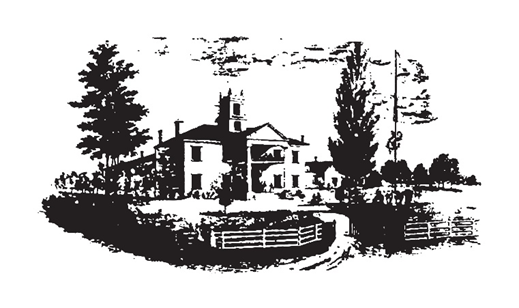
Dear WHS Members,
What a year we are having! From the overwhelming success of our Tour of Homes to another amazing trip to Natchez, a fantastic Harvest Arts Concert to a wonderful May meeting with our Guest Speaker, Cart Blackwell, we continue to set new standards of excellence. Thank you for supporting the work of our Historical Society.
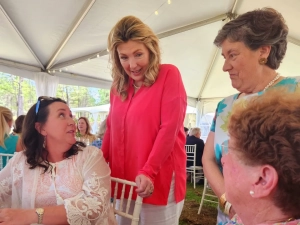 First, our Tour of Homes was an incredible success thanks to the amazing homeowners who so graciously opened their homes. I want to thank them again for their hard work and for the investment they made to prepare for Tour. Our guests loved your homes and the entire town of Pine Apple. Thank you all!
First, our Tour of Homes was an incredible success thanks to the amazing homeowners who so graciously opened their homes. I want to thank them again for their hard work and for the investment they made to prepare for Tour. Our guests loved your homes and the entire town of Pine Apple. Thank you all!
I also want to thank Sylvia and Tom Rushing for once again allowing us to host Friday’s Luncheon and the Welcome Reception with Lady Carnarvon at their beautiful home, Wakefield. It was the perfect setting for this remarkable event. Lady Carnarvon was very impressed with our organization and what we are achieving here in Wilcox County. She also loved Jackie Sharp’s Southern Cuisine. Thanks, Jackie, for creating a fabulous meal for her!
This year’s Tour raised $63,036.63 in profit! As a result of our success, we have allocated $16,000 to help restore the roof at Moore Academy and to restore the Water Tower Building as well. Both buildings are in the Pine Apple National Historic District.
The success of our last three tours has allowed us to help restore the Miller Law Office in Camden, the Furman General Store, and now these two buildings in Pine Apple. In fact, in less than three years we have raised over $250,000 through our tours, grant writing, and the generosity of many donors. As a result of our financial gains, we will start the restoration of the Female Institute this year.
the Furman General Store, and now these two buildings in Pine Apple. In fact, in less than three years we have raised over $250,000 through our tours, grant writing, and the generosity of many donors. As a result of our financial gains, we will start the restoration of the Female Institute this year.
Our second Natchez Trip was another amazing experience. Everyone thoroughly enjoyed the architecture, antiques, and food. The homeowners of Natchez really rolled out the red carpet for us. We will sponsor another Natchez Trip April 23 – 26, 2024. I encourage you to join us!
Thank all of you that attended the Harvest Arts Concert last month. As always, the music was incredible. We were the first stop on their Hymn Tour which included concerts in Pensacola and Birmingham. I want to thank the Camden ARP Church for hosting the concert. We will sponsor at least two more Harvest Arts Concerts; one this fall and one in the spring of 2024.
We have had a series of great Guest Speakers and that is going to continue this fall. We start Sunday, September 17th, at 2:00 pm, with the return of Sarah Duggan, Director of the Decorative Arts of the Gulf South Project in New Orleans. Sarah will present the findings of their work in both Demopolis and Greensboro. I hope you will all make plans to attend.
As you can see, we are making a big difference here in Wilcox County and beyond. We now have over 400 members from nineteen states. Thank you for being a part of this great organization.
Sincerely,
Lance Britt, WHS President
TOUR OF HOMES REPORT
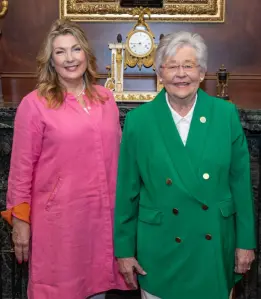
Lady Carnarvon’s visit, the beautiful homes in Pine Apple, and our previous years success all combined to bring over 1200 people to Wilcox County for our Tour Weekend Friday, March 24th – Saturday, March 25th. It was an overwhelming success in every way.
- We raised over $63,000 in profit from the Tour of Homes.
- We had people attend from 17 states.
- We sold over 1200 total tickets to the various events.
- Lady Carnarvon and the WHS Board attended a Welcome Event hosted by Governor Ivey at her office in the Capitol Building.
- State Treasurer Young Boozer also greeted Lady Carnarvon at the Capitol after our meeting with the Governor.
- Lady Carnarvon was impressed with everything about our organization and how our events were run. She has continued a dialog with us to try and help the WHS in other ways as well.
- 100 people attended Friday’s Luncheon at Wakefield in Furman.
- 450 people attended Friday Evening’s Welcome Reception at Wakefield.
- Over 700 people ate breakfast at The Brittany House Antiques in Oak Hill Saturday morning.
- Over 1000 people attended Saturday’s Tour of Homes in Pine Apple.
- It is the first time we have SOLD OUT every event associated with the Tour of Homes.
- We had more individual sponsors than any previous year.
- We have received overwhelmingly positive feedback from everyone that came.
- The 2024 Tour of Homes Dates are March 22 – 23, 2024
Here are the overall results:
2023 WHS TOUR OF HOMES TICKET SALES BREAKDOWN
$ 33,900 – Pre-Sold/Member Ticket Sales
$ 73,500 – Eventbrite/Online Sales
$ 6,018 – Day of Sales
$ 1,200 – Local Sales – Brittany House/Camden Jewelry & Gifts/Black Belt Treasures
$114,618 – Total Ticket Sales
In addition to thanking the homeowners of Pine Apple again for opening their homes and Sylvia and Tom Rushing for once again allowing us to use Wakefield, there are others we must thank as well:
- The Town of Pine Apple for being so accommodating.
- Martha Grimes Lampkin for her tireless efforts in promoting our Tour on social media while preparing two homes for the Tour.
- Mary Margaret Kyser for managing the over one hundred thousand dollars that moved into our accounts from November – March for the Tour, for keeping up with the many bills associated with the Tour, and for assisting in any way needed as Tour got closer.
- Jackie Sharp for cooking a fabulous meal for Lady Carnarvon on Friday afternoon before the Welcome Reception and for providing her with a fantastic hor d’oeuvres tray as well. She absolutely loved it.
- Patricia Harper and Madeline Felts for assisting Lady Carnarvon Thursday and Friday. They ensured that she had everything she needed and dealt with all the autographed books as well!
- Bart McCorquodale for providing us with a car and serving as Lady Carnarvon’s chauffer throughout her visit. He was an essential part of the weekend’s success.
- Commissioner’s Pit BBQ and Gaines Ridge for moving their operations to Pine Apple to provide our guests with lunch Saturday.
- The Moore Academy Alumni Association for allowing us to use the Gymnasium for lunch on Saturday.
- Wilcox Printing for creating the beautiful tickets for this year’s event.
Special Thanks to our 2023 Tour of Homes Sponsors!
Diamond Sponsors– Zoe and John Hunter, Dr. Sylvia and Tom Rushing
Platinum Sponsors – Lance Britt – The Brittany House Antiques at Oak Hill, Kathy and Andy Coats – National Christian Foundation of Alabama, Nancy and William Melton, Laura and Schley Rutherford
Gold Sponsors – Albritton’s Florist, McCorquodale Transfer, Town-Country United Bank
Silver Sponsors – Black Belt Treasures Cultural Art Center, Coast to Coast Hardware, Royal Restrooms
Bronze Sponsors – Camden Jewelry and Gifts, Camden Piggly Wiggly, Capell House Catering, Community Neighbor Bank, Gaines Ridge Dinner Club, Wilcox Area Chamber of Commerce, The Wilcox Progressive Era
Tour Sponsors – Holman Insurance, Whitaker Drugs, Woodmen Life Camden Chapter 1918
The Homes and Other Historic Sites
on the 2023 Tour of Homes
Friendship Baptist Church and Cemetery
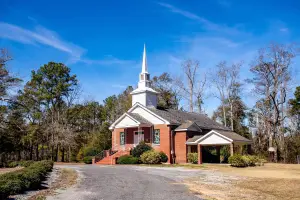
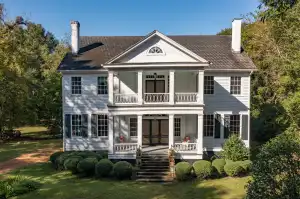
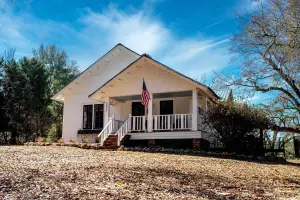
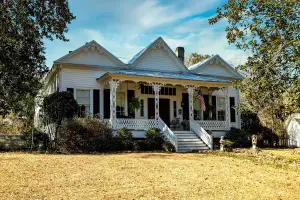
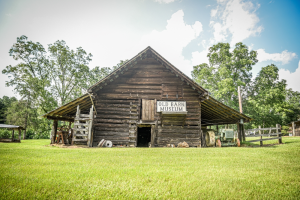

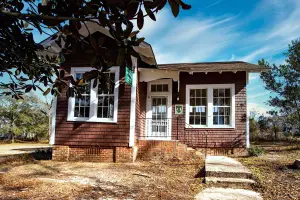 \In 1921 a small group of Pine Apple women met to form a literary club, The New Century Club. The members decided to build a library to further intellectual culture. It took two years to raise the necessary $1,235 needed to erect this building in 1927. It was used as a library until 1995. The one-story frame end gabled building features wooded shingle clad walls. Recently restored the library will be used as a museum for Pine Apple.
\In 1921 a small group of Pine Apple women met to form a literary club, The New Century Club. The members decided to build a library to further intellectual culture. It took two years to raise the necessary $1,235 needed to erect this building in 1927. It was used as a library until 1995. The one-story frame end gabled building features wooded shingle clad walls. Recently restored the library will be used as a museum for Pine Apple.
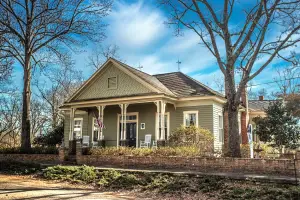
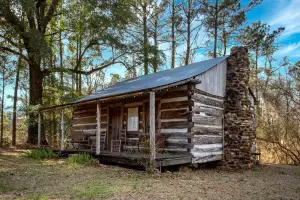

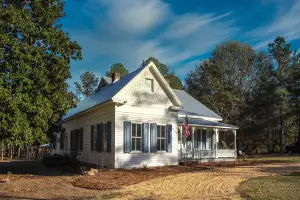
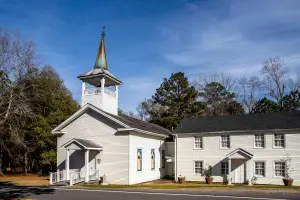
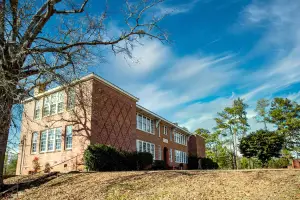
Four Oaks Bend – the Luckie-Williamson-Bennett House
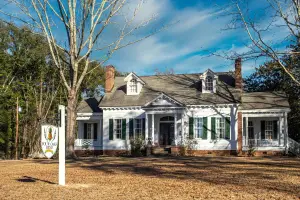
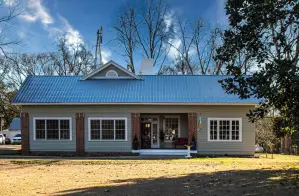

to new members: from Alabama –Dorothy Allain, Douglas Burtu Kearley Sr., and Jacquilyn Lynn Stewart of Mobile, Edward Allen Smith, Charles and Shea Terry and Beth and Mike Neighbors of Birmingham, Robyn and Clay Anderson, Robbie Dudley Klemm, and Terry Dudley Lott of Huntsville, Glynn and Joann Burleson of Thomasville, Valerie Pope Burnes of Livingston, Mr. and Mrs. Thomas Culpepper, and Linda and Ratliff McAdams, from Demopolis, Philip and Kimberly DeSimone of Trussville, Faye Estes, and Karen and Darrell Sparks of Monroeville, Madeline and Chase Felts of Minter, Grace and Joe Finklea of Vestavia Hills, Walter and Frances Givhan of Troy, Frank and Jeanie Lambert of Camden, Bill and Jennifer Mitchell of Bay Minette, Dr. and Mrs. Judson Moore of Dothan, and Jacqueline L. Stuart of Bay Minette, Nancy Waite of Satsuma and Dr. & Mrs. James Weir of Catherine. And welcome to new members Dr. Marsha E. Cline of Clearwater, FL, John and Zoe Hunter of Hilton Head, SC, Linda Metzler and Scott and Shea Moore of Jay, FL, Margaret Moore of Nashville, TN, Frances Moulder of Torrington, CT, Keith and Lee Norred of Columbus, GA, and Cynthia Nyberg of Willow Springs, NC!
CAMDENS WORLDWIDE
A few months ago, the WHS was contacted by David A. Hayes of the Camden History Society in London, England. He was interested in compiling a list of Camden place names across the globe to mark the 400th anniversary of the death of Elizabethan scholar, William Camden. With contributions from local historians and others in three continents the results were a sixty-page document filled with Camden history!
We were pleased that Camden native and Alabama historian, Daniel Fate Brooks, agreed to submit the entry for our Camden, Wilcox County, Alabama to Mr. Hayes. Following is our contribution to Camdens Worldwide:
City in and county seat of Wilcox County; population 1,900 (est.), elevation 63 m / 206 ft
By Daniel Fate Brooks
Thumbing the pages of Alabama history, one soon learns that the Wilcox County seat of Camden is greatly enriched by the Alabama River and other natural resources. The town, located in a bend of the river, lies on the edge of a distinct prehistoric and geological sub-region which gives rise to the twelve-county fertile crescent known as the Alabama Black Belt. From the many examples of antebellum architecture in the area, this land of rich soil brings to mind mid-nineteenth-century wealth and greatness, and also a culture and civilization that continue to shape state and national politics, history, art, tradition, and lore.
Wilcox County, founded in 1819, and one day older than the state of Alabama, is the southernmost county within the Black Belt region. From its first year of existence the county attracted aristocratic settlers from Virginia, the Carolinas and beyond. These cultured immigrants brought with them enslaved labor and built a high level of gentility which rapidly transformed a frontier wilderness into settlements reminiscent of their previous home states.
Along the banks of the Alabama River, ports and towns sprung up under the names of Black’s Bluff, Lower Peach Tree, Prairie Bluff and Canton. Inhabitants revealed in their connection to Mobile, but from the onset, suffered from the perils of disease plaguing their communities. In 1830 Wilcox Countians, including the populace of Canton, the first county seat, joined the citizens from eastern villages in their cravings for a center of government that was not only more healthy but also more centrally located.
By the fall of 1832 Thomas Dunn and his wife, Martha Hobbs, had donated twelve acres of wooded land in the center of the county for a new seat of government. The spot, four miles from the river, was rich with springs, providing an ideal location for its designated purpose. In swift succession the community, first called Wilcox Courthouse, grew, and was soon established and renamed Barboursville. Influential Virginia immigrants selected the name to honor Philip Pendleton Barbour, Virginia native and tenth Speaker of the U.S. House of Representatives.
The little town quickly swelled, attracting more settlers from the south Atlantic seaboard. In time an unusually large influx of small farmers and a powerful and wealthy planter elite from South Carolina filtered in to create a small version of the Palmetto State. This mix of inhabitants, combined with slave labor, produced a prosperous though highly imperfect plantation society. Among these newcomers was Dr. John Daniel Caldwell, a cousin of John Caldwell Calhoun, the forceful South Carolina Senator and U.S. Vice President. In 1841, Dr. Caldwell, a physician and politician, proposed incorporation, and the idea of renaming the town for Camden, South Carolina. Caldwell’s suggestions were overwhelmingly approved by the citizens who admir
Carolina. Caldwell’s suggestions were overwhelmingly approved by the citizens who admired his brilliant and passionate cousin.
Camden, Alabama adopted a South Carolina form of government, with the chief magistrate of the town serving as Intendant instead of mayor. The title of Intendant, derived from the French, was used by the city of Charleston and other South Carolina towns where the office was assisted by wardens.
A wide thoroughfare in Camden was named for Calhoun. Picket fences flowed in front of vernacular and classical styled homes spaced at intervals and surrounded by trees. Camdenians were proud to live in the new county seat, but they were equally proud of binding ties to the state of South Carolina.
Besides the immigrants from the south Atlantic seaboard, others came as well: English, Scotch, Irish, German, French and a young saddler who migrated from the Italian Alps. Jewish merchants owned businesses alongside their Christian counterparts, and all contributed to the polyglot blend of cultures, giving Camden a remarkable and cosmopolitan identity.
From the 1830s to the outbreak of the Civil War, hundreds of enslaved Africans were delivered by traders from the markets in Montgomery. In 1860 the Black population of Wilcox County numbered almost 18,000 to a White populace of less than 7,000. The census that year listed over 800 individuals as “mullatto” and recorded 26 as “free colored.”
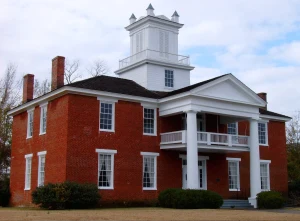
The brick Greek Revival building housing the Institute remains one of the town’s most significant landmarks, along with two church buildings, the monumental Greek Revival Courthouse and Dale Lodge, home to one of Alabama’s oldest Masonic orders. These structures have witnessed not only the glory days of cotton but also Civil War, slave emancipation, radical Reconstruction and other difficult times and events.
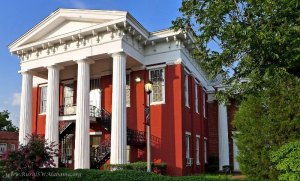
In an era in which large cities and more complex metropolitan areas dominate, it speaks well that Camden, Alabama, a town with a population with fewer than 2,000 in 2022, can take pride in claiming a history of notable sons and daughters, both African American and White. The list is long, but it is important to recognize Hank Aaron, the great American baseball player; Kay Ivey, current Governor of Alabama; Emmett Kilpatrick, an interpreter at the Versailles Peace Conference and a prisoner of the Bolsheviks; and Jeff Sessions, the 84th U.S. Attorney General and U.S. Senator.
Today people from all walks of life are drawn to the microcosm of Camden and Wilcox County, Alabama. Many come to hunt, fish, and enjoy the river. Others tour and view the historic architecture and marvel at a recent resurgence of business and renovation. Most visitors quickly develop a genuine respect for this small and intriguing Black Belt town.
DANIEL FATE BROOKS, a Camden native and a seventh generation Wilcox Countian, is a former president of both the Wilcox Historical Society and the Alabama Historical Association. He is the author of published articles on William Rufus King, Black Belt history and an unpublished manuscript on antebellum Wilcox County. He curated a portion of the landmark exhibition, Made in Alabama: A State Legacy for the Birmingham Museum of Art and authored a chapter on a Wilcox County subject in the accompanying book. Brooks, who was the Director of Birmingham’s Arlington Historic House, served as an adjunct instructor at Samford University for thirty-four years, and was the director of the Natchez Antiques Forum.
D O N A T I O N S
Many thanks for your gifts and continuing support!
A memorial, birthday, anniversary or just a nice way to say thank you can be done in a donation to the Wilcox Historical Society. Your donation is tax deductible. Donations can be mailed to: WHS, P O Box 464, Camden, AL 36726 or contact our Treasurer, Mary Margaret Kyser for more details. She can be reached at 334.324.9353 or m2kyser54@aol.com.
WHS February Meeting
Nature Within and Without at Bellingrath Gardens and Home
On Thursday afternoon, February 23, members, and guests of the WHS enjoyed hearing from Thomas “Tom” McGehee, Director of the Bellingrath Home in Theodore, Alabama, near Mobile. Bellingrath Gardens and Home was the creation of Mr. and Mrs. Walter Bellingrath. The Gardens first opened to the public in 1932.
Tom McGehee has served as the Museum Director for Bellingrath Gardens and Home for more than 20 years. In his capacity as curator over the collections there, he has participated in numerous study courses dealing with decorative arts and garden estates in the United States, Great Britain, France, and Germany.
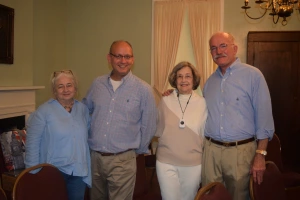 Tom spoke on Nature Within and Without at Bellingrath Gardens and Home – a look at the naturalistic themes found in both the Gardens and the Home. From the design of the Gardens and its historic cast iron elements to the ornate silver, porcelain, and furnishings within the Bellingrath Home, Tom showed us through outstanding photographs a consistent link to nature can be found and enjoyed at Bellingrath.
Tom spoke on Nature Within and Without at Bellingrath Gardens and Home – a look at the naturalistic themes found in both the Gardens and the Home. From the design of the Gardens and its historic cast iron elements to the ornate silver, porcelain, and furnishings within the Bellingrath Home, Tom showed us through outstanding photographs a consistent link to nature can be found and enjoyed at Bellingrath.
Pictured left with Tom McGehee (l to r) Ann Farrell Wright, Lance Britt, and Mary Ann Harrison.
It was interesting to hear from Tom a Bellingrath connection to Wilcox County! Mary Boykin was born in the Tilden community near the Wilcox County / Dallas County line. She later moved with her family to Brewton after the death of her father. In 1890 she married Edwin C. Bellingrath who was the older brother of Walter. Sadly, Edwin passed away in 1896 at the age of 43 and Mary moved back to Camden and lived with her aunt and sister until her death in 1936. Mary Boykin Bellingrath is buried in the historic Camden Cemetery.
The meeting was held at the Wilcox Female Institute with a reception afterwards.
WHS Trip to Bellingrath Gardens

HYMN TOUR CONCERT IN CAMDEN 
The Camden Associate Reformed Presbyterian Church was the venue for the Harvest Arts Hymn Tour on Sunday, April 30th. A large crowd enjoyed the concert sponsored by the WHS.
The concert featured exciting arrangements of beloved hymns fused with classical music. Hymns included “Amazing Grace,” “O the Deep, Deep Love of Jesus”, and “What Wondrous Love is This”, married with masterpieces by Dvorak, Mozart, and more…and even some Irish Jig.
Featured artists are nationally and internationally recognized musicians:
Madeline Cawley, FLUTE – Harvest Arts, LLC Creative & Artistic Director
Hannah Cope Johnson, HARP – Sarasota Orchestra
Paul Halberstadt, VIOLIN – Alabama Symphony
Lauren Peacock, CELLO – Alabama Symphony
Ethan Blake, CELLO – Alabama Symphony
A reception at the Wilcox Female Institute followed the concert.
DOWN HOME IN THE DEEP SOUTH:
THE ARCHITECTURE OF WILCOX COUNTY
Wilcox County has long been recognized for its unique architecture and culture. Our May meeting held on Sunday the 7th featured a most interesting presentation by Cartledge “Cart” Weeden Blackwell, III.
A native of Selma, Alabama, Cart is an architectural historian and the curator of the Mobile Carnival Museum. He obtained undergraduate degrees in art history and historic preservation from the College of Charleston and his MA in Architectural History from the University’s School of Architecture. His scholarly focus is on the art and architecture of 19th century and 20th century America, particularly that of the Southeast.
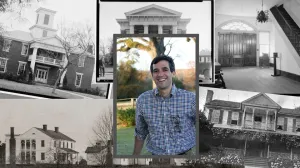 Showing hundreds of new and old photographs from homes and buildings across the county, Cart examined architectural styles, building types, construction methods, building processes, local figures (clients, builders, artisans, etc.) and much more.
Showing hundreds of new and old photographs from homes and buildings across the county, Cart examined architectural styles, building types, construction methods, building processes, local figures (clients, builders, artisans, etc.) and much more.
A crowd of nearly 70 members and guests enjoyed the afternoon celebrating the historical and continued importance of architecture in Wilcox County.
The meeting and reception were held at the Wilcox Female Institute – a most fitting locale for this subject!
Herbert John Furman April 4, 1933-May 5, 2023 Civil Engineer, Land Surveyor, builder, private pilot and sailor, Herb Furman was a man of many vocations and avocations. Born in Maine, raised in Kentucky, Herb was one of those people who came from somewhere else and made Wilcox County a much richer place for his presence. An engineering graduate of Auburn University, where he met his wife, Marian, Herb was civic minded and active in the community. He leaves Marian and his many children and grandchildren as evidence of his enduring contributions.
Maud Kirk Garrick, July 11, 1932- November 16, 2022 A Wilcox County native, Maud was born in Lower Peach Tree, AL. She was the daughter of Clarence Eugene “Uncle Bud” and Mattie Estelle Davis Garrick. She was the youngest of their six children. She was a lifelong member of the Methodist Church starting at the Lower Peach Tree Methodist Church. After high school graduation, Miss Garrick moved to Montgomery where she worked for several city and state government agencies. Her love of history led her to back to her roots. One of her greatest legacies is the Lower Peach Tree Homecoming, an annual event she began in 1980 and was active for 40 years. It was amazing the number of people from all parts of the country who had connections to Lower Peach Tree and wanted to visit it to reconnect. She is survived by a host of nieces and nephews.
Ann Morris Rutherford Lambert April 20, 1947-April 24, 2023 Ann Morris grew up in the Monroe County community of Franklin and was a resident of Camden for 50 years. Two of her gifts that she loved to share with family, friends, and her community were cooking and flower arranging. Ann Morris volunteered in many capacities over the years, including serving as president of the Wilcox Historical Society and co-chairman of its Tours of Homes. She is survived by her son, Leslie Lambert, daughter in law, Amanda, and grandchildren Miller and Emily.
Lathrop Winchester Smith, Jr. April 4, 1942 -October 27, 2022 A native of Birmingham, Lathrop began and ended his career at Industrial Supplies, Inc. (ISI), a regional distributor of bearings and power transmission equipment. Under his leadership as President from 1971 to 2003, the team at ISI grew the business significantly and opened branches in Alabama, Florida, and Mississippi. In 1987, Lathrop served as President of the International Bearing Specialists Association. As a lifelong member of Independent Presbyterian Church, he served as a Deacon, an Elder and a Trustee for the IPC Foundation. Lathrop was a member of numerous civic clubs and organizations in Birmingham, where he also served on their boards. He was a longtime life member of the Wilcox Historical Society, where he and his wife, Garland were very active. Most recently Lathrop was instrumental in starting the Raise the Bell campaign for the expansion and remodeling of the Wilcox Female Institute. He is survived by this wife of 52 years, Garland Cook Smith; his son Lathrop Winchester Smith III (Brannon); his daughter Lindsay Smith Puckett (Jason); his granddaughter Dorothy Ann Smith, his grandson Lathrop Winchester Smith IV. Lathrop was a man who will be remembered for his love for people and the ability to make them laugh.
Give the Gift of Membership 
Gift memberships are now available! Help us grow our membership and take pride in the history of Wilcox County. If you are interested in gifting a membership to a friend or family member for a birthday or other special occasion let us know. We will mail them a beautiful gift certificate along with our latest newsletter. For more information, please contact us at wilcoxhistoricalsociety@gmail.com.
HER MAJESTY THE QUEEN
Written by Frances Donald Dudley Grimes in 1977 – the Silver Jubilee of Elizabeth II
Part Two
The new king was cheered and embraced by his people, for all seemed to share his wish to bury the past. It was like a scandal in the family where a foreigner had played the leading role.
On February 17, 1937, Princess Elizabeth with her family moved into Buckingham Palace. Her relationship with her younger sister Princess Margaret Rose was also altered by the events of 1936, for until then, they had been equal despite the 4-year gap in their age. Margaret was a bright, vivacious little girl and the relationship between the sisters has always been close. Had it not been, it could not have survived the strains placed upon it in adult years.
May 12th, 1937 was the date for the crowning of the new king and Britain became gripped with monarchial fervor.
Through March and April Miss Crawford’s theme for the little princesses’ lessons revolved around King George’s coronation and Queen Mary explained the roles, symbolisms, and rituals, thoroughly to her granddaughters. In preparation, Princess Elizabeth was brought out to stand by her parents at some of their public engagements.
The princesses’ robes for the coronation were their first long dresses. Margaret rode to the Abbey with Queen Mary, who for once in her life was breaking with tradition for over the centuries it had been a royal superstition for the widow of a king to attend the coronation for his successor, but Queen Mary saw good reason after the events of the previous December to demonstrate royal solidarity in defiance of ill omens.
Princess Elizabeth, heir presumptive but not heir apparent for that is given to first sons of British Sovereigns and a baby brother was what the little princess was praying for but King George VI and Queen Elizabeth were perfectly satisfied with the size of their little family. Elizabeth idolized her father both as a dutiful daughter and as his heir.
In July of 1930, she with her father, mother and sister went on a cruise along the South Coast and dropped anchor off Dartmouth Royal Naval College where King George VI had concluded his education. Though only 13, Princess Elizabeth first met Prince Phillip, the young man she was later to marry. He was just 18 and although called Phillip, Prince of Greece, did not have a drop of Greek blood in his veins. He was in essence a Dane, which his ash blond hair and angular features signified. As Miss Crawford noted, Elizabeth was attracted to him from the very first.
On September 1938, Britain declared war on Germany. King George had to decide what to do with his daughters. One option was to evacuate them to Canada as so many were doing but as Queen Elizabeth said, the children would not leave without her, she would not leave without the King and the King would never leave. Windsor seemed the safest place and after Dunkirk and the fall of France, they moved into Windsor Castle where Elizabeth spent the remainder of her childhood and today, she still considers it home.
On May 8, 1945, London celebrated the unconditional surrender of Germany. Sir Winston Churchill declared that King George and his family had more closely identified themselves with their people in war than any of their predecessors for each had taken part in sacrifices for the war effort but the cost of the continuous strain upon the King’s health had been high.
In the summer of 1946, Elizabeth let her feelings for Prince Philip become known to her family but being discrete, she did not broadcast it to the world. On July 10th 1947, the King and Queen announced the engagement of their daughter, Princess Elizabeth to Lt. Philips Mountbatten, R. N. from Buckingham Palace.
The people, starved for joy, celebrated with her as graciously as they knew how. The House of Commons voted 50,000 pounds for Clarence House to be decorated and in addition to 10,000 pounds for her young husband and 50,000 for his bride. On November 20, 1947 they were married in Westminster Abbey amid one of the largest gatherings of Royalty of the century. More than 200,000,000 people heard by radio the service preformed by the Archbishop of Canterbury.
On November 14, 1948 the nation was thrilled to learn that the princess had given birth to a son christened Prince Charles Philip Arthur George of Edinburgh and in 1950 a princess was born christened Ann Elizabeth Alice Louise.
The King’s illness in 1949 imposed a heavier burden of duty on Princesses Elizabeth, and her children were often in the care of Queen Mary.
In January 1952, King George VI was too ill to undertake the tour to Australia and New Zealand and Elizabeth and Philip went instead. It was in Kenya on February 6, 1952 that she received the news of her father’s death and that his mantle had fallen on the shoulders of his daughter who returned to England as Queen Elizabeth II.
Kling George VI was laid to rest at Windsor and Britain prepared for the coronation of Queen Elizabeth II. Queen Mary, the much beloved grandmother died in 1953, shortly before the coronation, which took place in Westminster Abbey on June 2, 1953. In 1960 a second prince was born to the Queen and Prince Philip and christened Andrew Albert and a third son, Prince Edward Richard Lewis was born in 1964.
The mid-60s were busy years for the Queen and Prince Philip. In 1967 a plaque was unveiled in the mall in memory of Queen Mary and for the occasion the Duke and Duchess of Windsor came to London for the first time as man and wife. In 1969 Prince Charles’ investiture as 21st Prince of Wales took place at a magnificent ceremony at Caernarvon Castle. (I was there soon after and many of the trappings still in place.)
Almost the last decision that Winston Churchill took in June of 1953 before his stroke was an intimate and delicate matter concerning Elizabeth II’s family. It pertained to the Queen’s sister, Princess Margaret, who had fallen in love with Group Capt. Peter Townsend and which created a touching problem for the Queen. Not only did he not possess the qualifications of birth expected of princesses but was that he was 16 years her senior, but he was also divorced. The conflict was doubly agonizing for she not only sought the happiness of her sister, she was very fond of Peter Townsend whom she had known for more than 10 years and who had served her father as an Equerry and Comptroller at Buckingham Palace. She loved her sister and wanted her happiness but there were matters of protocol which she could not ignore.
Under the Royal Marriage Act of 1772, members of the family in line of succession to the throne had to have the sovereign’s consent if they wished to marry before the age of 25. Since this act was a statue, Elizabeth was bound to act upon the advice of the Prime Minister. It was decided to send Peter Townsend to Brussels as an air attaché for two years. It was not love that the Queen wished to discourage, only scandal and in two years’ time it would prove how strong that love remained. On August 22, 1955, Margaret reached her 25th birthday and in theory she was free to marry Peter Townsend but in order to do so, she would have to renounce her right to her succession and waive all claims to her official income.
The Queen had chosen not to obstruct her sister and to let her make up her own mind. Margaret and Peter Townsend met on Wednesday, October 26, 1955 and both decided they had trespassed long enough on Elizabeth’s willingness to let them make up their own minds and causing her so much anguish and because of that, they should not marry. On October 31, 1955, she released this statement publicly, “I would like it to be known that I have decided not to marry Group Capt. Peter Townsend. I have been aware that, subject to my renouncing my right of succession, it might have been possible for me to contract a civil marriage. But mindful of the church’s teaching that Christians’ marriage is indissolvable and conscious of my duty to the Commonwealth, I have resolved to put these considerations before others. I have reached this decision entirely alone, and in so doing I have been strengthened by the unfailing support and devotion of Group Capt. Townsend. I am deeply grateful for the concern of all those who have constantly prayed for my happiness,” signed Margaret.
As you know she later married Mr. Armstrong Jones on May 6, 1960 which proved a stormy marriage and they were separated on March 19, 1976. I tell of Elizabeth’s visit to Duke in France and the Duke of Windsor died of cancer in May 1972 and buried in the royal burial place of Frogmore. Space was reserved for Wallis who would lie in royal ground at last.
It has often been said that the Queen and Prince Philip are the best ambassadors that Britain has every had. They are each other’s closest colleagues and their offices are side by side at Buckingham Palace. His contribution to the life and work of Elizabeth II is estimable. As she said on the night of November 1972 after celebrating their silver wedding anniversary, “that every one would concede that she should begin her speech with my husband and I.”
This year, 1977 is the Queen’s Jubilee Year. More than half a century after her grandfather set his style of dutiful representative monarchy, the same style reigns under the protection of Elizabeth II and her family, she is not ashamed – in fact – is proud to be the figure head of a welfare state and populist Democracy whose ethics opposed to the monarchical traditions of her forbears. She is a magical focus for affection, pride, and loyalty which the majority of people are very happy to accept. And if they ever become unhappy with her or the system that she represents then she would have no doubts to where her duty lay. And if Britain were one day to decide it no longer needed the monarchy, her response would be the logical continuation of her entire life, to country, indeed would be her ultimate service.
EARLY RIVER DAYS IN WILCOX COUNTY (Part 2)
Besides the pleasure angle, there were other sources of intense rivalry between boats – their pilots, crews, and even the passengers. The boats indulged in cut-rate fares and freight rates, which competition let to bitterness, brawls, and bodily injuries – in one case recorded by Judge Fleetwood Foster in the Wilcox Banner – to attempted murder. It happened this way: Having slashed fares from Mobile to Montgomery to a meager $2.50, tow rival captains, Bob Otis, then captain of the St. Charles, and James Green, captain of the F. P. Kimball, left Mobile in a high dudgeon. Near Claiborne, the St. Charles, which was the faster boat, in the act of passing the Kimball, bore down on it, causing it to swing heavily to shore. Captain Otis, later claiming protection of his boat and crew, drew his gun and fired point blank at the pilot of the Kimball was who badly though not mortally wounded.
The rivalry among boats for transporting cargo and passengers, however, could not compare with their rivalry for speed. The number of boilers, the size and draught of the vessel, the stroke of the engines, its load and number of stops, all determined the time to complete a trip, but slicing off a few hours from Mobile to Montgomery, a river distance of 415 miles, was a source of great boasting – a feat eliciting minute comparisons and a variety of explanations, both factual and fanciful. The James Battle was one of the fastest boats on the Alabama, and a record run from Bridgeport Landing to Montgomery, a distance of 175 miles upstream, in fourteen hours averaged twelve and a half miles per hour – a record almost equal to that of the matchless Robert E. Lee in its race against the Natchez when it averaged fourteen miles. The trip by river from Montgomery to Mobile with stops, upstream, took two full days or more at the best. One of these Packets named “The Wilcox” (for our county) was a favorite for local use – she as a fast boat, and like many of these boats, she was cut down, armed, and used as a blockade runner during the War Between the States.
But the boat races, held for no other purpose than to determine the one of greater speed, were usually held non-stop between the mouth of the Mobile River and the confluence of the Alabama and Tombigbee about fifty-miles upstream. Mobs crowded the wharf at Mobile as the passenger-crammed vessels set out – smaller vessels followed in their wake to learn the outcome to return the following day to give an account of the race. Among the jubilant crew and loyal passengers, as well as the proud owners and builders of the vessel, there were many who returned home richer or poorer by a bag of gold, a plantation, or a race horse or two.
But the river had its hazards. From the many catastrophes that befell the old packets and their freight as well as passengers, steam boating was anything but a tranquil pursuit. Waters of the Alabama River running through Wilcox County still entomb the remains of many of these old vessels and their human victims. There was the Senator No. 2 which blew up and sank at Young’s Landing; and the C. W. Dorrance, running in a fog, hit the wreckage and sank on top of it. (Incidentally, the pilot of the Dorrance was Capt. Billie McCurdy, Mrs. Laura Lee Moore’s grandfather.) There was the Joab Lawrence which sank at Yellow Jacket Bluff, the Commadore Farrand at Packer’s Bend, the Jewess at Prairie Bluff, and the Orleans St. John at Hurricane Bluff. An unidentified sunken craft lies upstream from the Orleans St. John which is thought to have been a slave ship, and it is believed that the wreck may contain skeletons of slaves still shackled in its hold. In these collisions and explosions many a man lost his life’s investment and many a gambler lost his gold; but what was more tragic, many officers, crewmen and passengers lost their lives to scalds, burns, drownings, and exposure.
But it was neither the sober traveler nor the flamboyant gambler who kept the old paddle-wheelers chugging up and down the river; it was King Cotton and him alone. The James. T. Staples, later named the Peerless and again the Helen Burke, once moved five thousand bales of cotton on its decks and on barges lashed alongside and in town, from Selma to Mobile. The owners of river landings provided warehouse with stalls – rented to inland merchants and landowners – where their merchandise, brought up by boats relieved of their cotton cargo, might be stored until wagons could haul it out to their respective stores or commissaries.
A windlass, usually fashioned from a massive tree trunk, mounted upright to turn on a stationary core and operated – rather like a cane mill – by a mule hitched to a beam inserted in the tree trunk. Wound up the cable which in turn hauled up, over steel rails, a triangular fashioned carriage on rollers, loaded with luggage and freight. The cotton meanwhile was rolled down a ramp or cleared place on the river bank and caught and stacked by singing, sweating, swearing deck hands below. The passengers walked to and from the boat via a flight of steps extending from bank to water’s edge – possible a record for such a flight being recorded in the neighboring county of Monroe at Claiborne of three hundred and sixty-five steps! The bustle and noise of a boat’s arrival, its unloading and reloading, were as gay and joyous as its departure was serene and sad.
Homes of river-landing proprietors became, of necessity, hotels of sorts where passengers, who were waiting for boats which might be hours late, could “put-up” and where arrivals who were unmet or could not get out because of impassable roads or inclement weather might wait for rescue.
At times these landing owners were bothered to distraction by the impatience of waiting passengers. One such, at old Bridgeport Landing, Mr. Wirt Moore – who never allowed a male, either doddering old or shirt-tail young, to sit at his dining table without a coat – was once beset by a youth as to when his boat would arrive. Not being a diviner of anything so unpredictable as a steamboat’s time-table, Mr. Moore advised patience and again patience. Finally, a boat whistled around the bend, and the young traveler, still not satisfied, rushed to inquire of Mr. Moore how long it would take the boat to arrive after its whistle was heard around the bend.
Mr. Moore eyed him in exasperation. “Son,” he said, “I wouldn’t rightly know. One whistled around that bend twenty-five years ago, and it ain’t got here yet.”
(To be continued in the WHS Summer newsletter.)
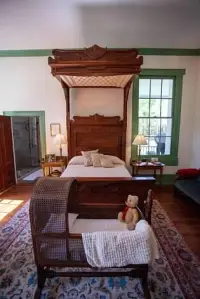
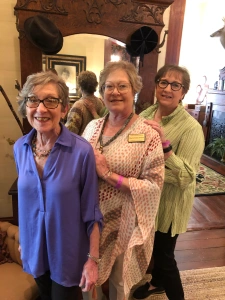
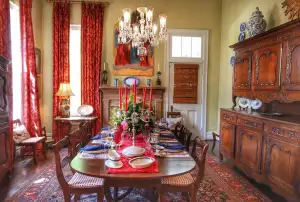

(Thanks to Mickey Mathews, Melanie Dees Andress and homeowners for photos)
Recollections of the Stave Mill
By Harold “Hal” Watts Grimes Jr. of Pine Apple, Alabama
Dallas Cooperage Company came to the Pine Apple area just after World War II, about 1946 or 47. The first mill in our area was located across County Road 7 from the Godwin place. It had a number of houses where the workers lived. The mill was powered by a steam engine. Water for the boiler was pumped from Turkey Creek about one half mile.
The staves were made from pine logs that were sawed into blocks the length of the staves. They were then cut with special saws to give them the curved shape. These staves were then dried and tied into bundles for shipment. They were shipped by rail on the L&N Railroad from the Pine Apple Depot to another location where they were fitted with the ends or heads and made into small barrel shaped containers known as kegs. These containers were used to ship nails, horseshoes, chain etc., to hardware and farm supply stores.
Other locations of mills in our area were at Mount Moriah, one between Awin and Pine Flat, and the last one near Ruthven. Much of the machinery is still in the abandoned Ruthven facility. The manufacturing process was very labor intensive and dangerous for the workers operating the saws. The Ruthven mill was converted from steam power to electricity. It had a dry kiln and packaging shed.
RUTHVEN
The Wilcox Progressive Era described this town in April 1922: “Ruthven is a railroad and saw mill station on the L. & N. R. R. in Fox Mill Beat, and is located between Pine Apple and Schuster Springs stations. The name of the mill is Schuster Springs Lumber Company. This company is owned by W. P. Smith Lumber Company of Chapman, Ala. and has a 14 mile rail timber road. The daily capacity of this mill is 65,000 feet of lumber. About 300 men are employed in the mill and in the woods.
The company has a store, or commissary, and also a hotel operated by Mrs. Bearsfield. The post office is Ruthven and Mr. D. C. Snowden is post master. The view from the rudimental portion of the town is very pretty and industrially inspiring.”
According to Place Names in Alabama by Virginia O. Foscue, “A resident who came from Lincolnshire, England, wanted to name the settlement Lincoln, but after his neighbors objected, he called it, instead Ruthven for a division in the English County. (Editor’s note – Ruthven is a parish in the county of Forfor, Scotland, situated on the north side of Strathmore, near the base of the Grampian hills.)
Ruthven, Wilcox County, Alabama was incorporated in 1924. It was located about 3 ½ miles southwest of Pine Apple on Bear Creek along the Selma to Flomaton branch of the Louisville & Nashville Railroad (now County Road 2.) In 1930, it had over 500 residents making it the second largest town in Wilcox County after the county seat of Camden.
In May 1952 officials of the W.M. McGowin Lumber Company announced their plans to discontinue operations at the Ruthven Mill. At that time the mill employed about 150. McGowin Lumber was the largest industrial plant in Wilcox County in 1952. The plant’s capacity was 35,000 feet of lumber a day. McGowin Lumber shipped lumber over the Eastern part of the United States as well as worldwide.
Very little exists of the town today as most of its buildings were dismantled.
UPDATE Broken Arrow, Sunny South, Alabama
From Erskine “Don” Donald
This historic home is located 4 miles south of the community of Sunny South in western Wilcox County. The property fronts on the west side of Wilcox County Road 1 and lies south of State Highway 5. According to historical records, the home was built circa 1830 by the Vaughn family, one of the earliest families to settle Wilcox County. It is a simple one-story cottage constructed of heart pine throughout with a basement beneath. The exterior has never been painted. The home and grounds were occupied by Mrs. Pearlie Smith and family under a 1966 life estate agreement from the Fred Vaughn Trust until May 24, 2017 when the home and appurtenances on 7.79 surveyed acres were donated to the Wilcox Historical Society. WHS continued the life estate agreement with Mrs. Smith until her death on December 25, 2021.
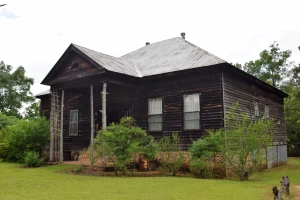 Pearlie Smith had contacted members of WHS in May 2016 concerning the perpetual preservation of this historic home and appurtenances known as Broken Arrow. WHS spearheaded this project, and through the efforts of Bill Godbold and Donald McLeod, Trustees for the Vaughn Trust and Frank Cascio of Weyerhaeuser which has the timber lease on the Vaughn Trust property, the Society was able to secure this property. The deed to Wilcox Historical Society provided that the property can be sold after the expiration of Mrs. Smith’s life estate but stipulated that the home and all appurtenances must remain on the property, thus assuring that this historic property will be preserved.
Pearlie Smith had contacted members of WHS in May 2016 concerning the perpetual preservation of this historic home and appurtenances known as Broken Arrow. WHS spearheaded this project, and through the efforts of Bill Godbold and Donald McLeod, Trustees for the Vaughn Trust and Frank Cascio of Weyerhaeuser which has the timber lease on the Vaughn Trust property, the Society was able to secure this property. The deed to Wilcox Historical Society provided that the property can be sold after the expiration of Mrs. Smith’s life estate but stipulated that the home and all appurtenances must remain on the property, thus assuring that this historic property will be preserved.
The property was put on the market for sale in December 2022 and a contract with Linda Baird and Woody Goode was signed in late January 2023 for a total price of $66,000. The sale was closed in March 2023 and Linda and Woody began restoration of this home.
The John Purifoy Family: An Early Family to Alabama,
A Founding Family of Furman and Wilcox County and Their Duty for the Confederacy
By Kimberley Purifoy Stout, Little Rock, Arkansas
John Purifoy (my third great grandfather) was born 21 September 1787 in Craven County North Carolina. His parents were Nicholas Purifoy Jr. and Mary (Gatlin) Purifoy of Craven County North Carolina. [1] After the death of both parents and around 1800, John moved to Hancock County Georgia with his older brothers William Dixon Purifoy and Arrington Purifoy. [2]
On 21 December 1809, in Hancock County Georgia, John married Nancy Williams. [3] Nancy (my third great grandmother) was born 23 March 1792 in Hancock County Georgia. Her parents were William Williams and Evelin Mullins Williams. A few years after marriage, John Purifoy took his constitutional oath on 20 May 1814 in Sparta Georgia. He was Ensign John Purifoy of the 14th Regiment of the Militia of Georgia [4] and a farmer. John and his family moved to the Barbour County Alabama area prior to 1820 [5], making him an early settler to Alabama. Dr. W. B. Palmer writes that John Purifoy about 1820, settled across Rutherford Creek about two miles north going from Old Snow Hill. [6] At that time, many settlers moved from Georgia to Alabama in search of fertile farming land and for trade with the local Indians.
Around 1826, the settlers decided to build a road from Eufaula to Clayton, Alabama to enhance the Indian trade. John Purifoy was the overseer of around three hundred men for the working force. Interesting is that as the men reached Barbour Creek, they were startled by yelps and yells from a group of Indians that were in the woods. The Indian interpreter stated that the Indians did not approve of the road and that the workers need to show an order from “The Great Father in Washington.” [7] The road workers were unable to show any documentation so; they packed up their tools and equipment and retreated to their homes.
Later, an officer from nearby Fort Mitchell met with the Indians and convinced them that the road would bring in more produce, goods, and supplies into the area. The Indians agreed and the roadwork started again with some the Indians taking part in the construction. The ford at Barbour Creek and the road to Clayton were completed and more productive trading relations were established. [8]
The U.S. Census of 1830 lists John Purifoy as living in Pike County Alabama. [9] On 1 August 1831, he purchased land in Cahaba Dallas County Alabama and moved his family there. [10] He then purchased additional land in Cahaba Dallas County on 19 September of 1835. [11] John Purifoy died on 25 August of 1839 while visiting in Shelby Springs, Alabama. He is buried in the Old Shelby Cemetery in Shelby County Alabama. U.S. Census records reveal that John Purifoy’s occupation in Alabama was farming. Nancy Purifoy is listed in the U.S. Census of 1840 as living in District 574, Alabama (Early GA) [12], the U.S. Census of 1850 as living in Dallas County Alabama [13] and she is listed in the U.S. Census of 1860 as living in the Eastern Division of Wilcox County Alabama. [14] The U.S. Census of 1870 lists Nancy as living with her widowed daughter, Patience Caroline Purifoy Lee in Snow Hill, Wilcox County Alabama. [15] Nancy Purifoy died on 9 May of 1875 in Snow Hill. She is buried in the historic Old Snow Hill Cemetery in Wilcox County Alabama.
The Furman National Historic District historical marker was installed in April of 2010 at the west side of County Road 59. This historical marker reads that the earliest settlers to Furman came from the Carolinas and that family groups include, among others, the Carters, Gulleys, Lees and Purifoys. [16] Furman historic landmarks associated with the Purifoy families include the Patience Caroline Purifoy-Lee House (also known as Patience Plantation), the Purifoy-Lipscomb house, and the Purifoy-Melton-Norred house that was built in Furman but was later dismantled, moved to Pine Apple Alabama, and rebuilt. [17]
The Purifoys were also founding families of the historic landmark Bethsaida Baptist church [18]. It might be of interest to know a bit of Baptist history about John Purifoy’s grandfather, Nicholas Purifoy Sr. (1679 VA – 1773 NC). Nicholas Purifoy, along with other men from Craven County petitioned the court of New Bern, North Carolina in June of 1740, to build a Baptist house of worship [19]. Remember that in 1740, the Church of England (Anglican) was the established church and everyone paid a tax for the upkeep of Anglican churches. Some of the petitioners including Nicholas Purifoy were placed in the Craven County jail for a couple of months. In September of 1740, Nicholas Purifoy along with the other men petitioned the court again to hold Baptist church services. This time, the justices of the Craven County Court agreed to the petition and these Baptists were then able to have the freedom to worship their Baptist beliefs [20].
The Purifoy families were proud of their family members who fought with bravery and great sacrifice during the Civil War. After the election of President Abraham Lincoln in 1860, Alabama delegates voted to secede from the United States. Alabama provided a significant source of soldiers to the war and there were many young male Purifoy family members who joined in the war effort. It appears that military service was part of their familial duty and perhaps failure to do their part would bring shame to themselves and their families.
John and Nancy had ten children in number. There were eight children reared by John and Nancy and two children that died at young ages. The attached chart lists the Purifoy children and their connections to Furman and Wilcox County. Also included is information of members of the family who were Confederate Soldiers. [21]
Notes [1] Rose, F. (1981) Henry Marshall Purifoy Genealogy – Ancestry and Descendants [2] Wood, R. & Wood, V. (1964) 1805 Georgia Land Lottery [3] Georgia U.S. Complied Marriages 1754-1850 (FamilySearch website) [4] Georgia Department of State – Department of Archives and History Atlanta GA. Minutes of Court of Enquiry 14th Regiment of the Militia of Georgia 20 May 1814 [5] Owen, T. M. (1921) History of Alabama & Dictionary Alabama Biography Volume I p. 119 [6] Palmer, W. B. (1916) Sketches of Alabama Towns and Counties A Collection Vol. 1 A-F Chapter XI: A History of Furman Alabama p. 218 [7] Owen, T. M. (1921) History of Alabama & Dictionary Alabama Biography Volume I p. 120 [8] Owen, T. M. (1921) History of Alabama & Dictionary Alabama Biography Volume I p. 120 [9] 1830 United States Federal Census Pike County Alabama [10] United States General Land Office Records 1776-2015 1 August 1831 No. 6992 [11] United States General Land Office Records 1776-2015 19 September 1835 No. 15234 [12] 1840 United States Federal Census District 574 Alabama (Early GA) [13] 1850 United States Federal Census Dallas County Alabama [14] 1860 United States Federal Census Eastern Division Wilcox County Alabama [15] 1870 United States Federal Census Snow Hill Wilcox County Alabama [16] Rural SW Alabama (website) – Furman National Historic District Historical Marker [17] Furman Historic District Registration Form and Application of 28 January 1999 United Sates Department of Interior and National Park Service [18] Furman Historic District Registration Form and Application of 28 January 1999 United States Department of Interior and National Park Service [19] Paschal, G. W. (1930) History of North Carolina Baptists Volume I 1663-1805 p. 187 [20] Paschal, G. W. (1930) History of North Carolina Baptists Volume I 1663-1805 p. 191 [21] Owen, T. M. (1904) Alabama Historical Society Vol. IV 1899-1903 Transactions AL Historical Society 1899-1903 Chapter IV Descendants of John Purifoy Who Were Confederate Soldiers pp. 441-444 [22] Lowndes County Historical Society (1978 Oct.) Volume 11, Number 4 [23] Palmer, W. B. (1916) Sketches of Alabama Towns and Counties A Collection Vol. 1 A-F Chapter XI: A History of Furman Alabama p. 219
| Children of John & Nancy Purifoy with Military Service | Birth & Death | Date & Place of Marriage / Spouse | Birth & Death of Spouse | Connections to Furman and Wilcox Co |
| William Madison Purifoy 3 sons who served as confederate soldiers- Dr John Harrod Purifoy-44th AL Regiment, Judge Williams Purifoy-Co. B 1st AL Regiment (combat fatality) and William Madison Purifoy-under Capt. Henry Milner | Born 29 Nov 1810 Hancock Co GA Death 7 July 1863 Buried at Purifoy Cemetery CR59 Wilcox Co AL | 3 Apr 1831 Married to Mary Harrod at Barbour Co AL | Born 29 May 1817 Bullock Co GA Death 18 Jun 1860 Buried at Purifoy Cemetery CR59 Wilcox Co AL | Farmer in Wilcox Co and held a position of Justice of the Peace. He was the original owner of the historic Purifoy-Melton-Norred house. His son Dr. John Harrod Purifoy lived in the Purifoy-Lipscomb house. |
| Henry Marshall Purifoy (My 2nd GGF & progenitor of my family line) Confederate Officer-Captain in Co. G 15th AR Infantry & POW and two sons who served as confederate soldiers- Henry Harrison Purifoy-Co G 11th AR Infantry & John Griffin Purifoy-orderly for Gen. Price | Born 10 Nov 1812 Hancock Co GA Death 9 Aug 1882 Buried at Purifoy Cemetery Ouachita Co AR | 1 Jun 1834 Married to Frances Sytha Griffin at Wilcox Co AL 2nd Marriage 10 Dec 1851 Married to Martha Jane Elizabeth Handley (2nd GGM) at Ouachita Co AR | Born 1 Jan 1819 Georgia Death 5 March 1851 Buried at Purifoy Farm Ouachita Co AR Born 5 Jan 1833 Death 22 Jun 1889 Buried at Purifoy Cemetery Ouachita Co AR | Married in Wilcox Co AL & Baptized at Cedar Creek Baptist Primitive Church in Wilcox Co. AL on 22 Sep 1843. [22] Moved from Dallas Co AL to Ouachita Co AR in 1845 |
| Martha Williams Purifoy/ Hobdy 1 son who served as a confederate soldier – William Madison Hobdy-Co C 44th AL Regiment | Born 6 Sep 1814 Hancock Co GA Death 25 Dec 1911 Buried at Historic Old Snow Hill Cemetery Wilcox Co AL | 5 Jan 1829 Married to Edmond Hobdy at Pike Co AL | Born 14 Jul 1805 North Carolina Death 6 Dec 1861 Buried at Historic Old Snow Hill Cemetery Wilcox Co AL | Edmond Hobdy: Farmer in Wilcox Co. Donated land for the construction of the historic Bethsaida Baptist Church. Possible builder of the historic Purifoy-Lipscomb house and the historic Fox Hill house |
| Leroy Purifoy 3 sons who served as confederate soldiers- John Gulley Purifoy-Co H 19th AR Infantry, William Leroy Purifoy & Thomas Henry Purifoy –Co F 15th AR Infantry (both combat fatalities) | Born 2 Dec 1816 Hancock Co GA Death 17 Dec 1874 Buried at Gulley Cemetery Nevada Co AR | 23 Aug 1835 Married to Elizabeth Gulley (sister of James Haywood Gulley) at Dallas Co AL | Born 25 Feb 1819 Monroe Co AL Death 17 Dec 1874 Buried at Gulley Cemetery Nevada Co AR | Moved from Dallas Co AL to Ouachita Co AR in 1840s |
| Francis Marion Purifoy 4 sons who served as confederate soldiers- John Purifoy-Jeff Davis Artillery Selma, James Wesley Purifoy-Co B 1st AL Regiment (combat fatality), William Scott Purifoy-Co F 53rd Al Regiment & Edmund Hobdy Purifoy-Co C 44th Al Regiment | Born 4 Oct 1818 Hancock Co GA Death 31 May 1858 Buried at Historic Old Snow Hill Cemetery Wilcox Co AL | 22 Apr 1841 Married to Nancy Lucy Thigpen at Butler Co AL 2nd Marriage 13 Oct 1846 Married to Penelope Ann Moore at Wilcox Co AL | Born 23 Nov 1821 Butler Co AL Death 20 Jul 1846 Buried at Historic Old Snow Hill Cemetery Wilcox Co AL Born 28 Oct 1830 Death 5 May 1879 Buried at Prairie Point Cemetery Navarro Co TX | Farmer in Wilcox Co. He was the original owner of the historic Patience Plantation house. [23] His son John was a Probate Judge in Wilcox Co, AL State House Representative, State Auditor, State Treasurer, and later became Secretary of State for AL. |
| Mary Ellen Purifoy/ Gulley 1 son who served as a confederate soldier- Henry Calhoun Gulley-Co F 15th AR Infantry (combat fatality) | Born 28 June 1820 Hancock Co GA Death 11 Nov 1857 Buried at Fellowship Cemetery Union Parish LA | 28 Feb 1836 Married to James Haywood Gulley (brother of Elizabeth Gulley) at Dallas Co AL | Born 14 Nov 1814 Duplin Co NC Death 5 May 1859 Buried at Bremond Cemetery Robertson Co TX | Moved from Dallas Co AL to Ouachita AR in the 1840s, then to Union Parish LA |
| Captain John Wesley Purifoy Confederate Officer in 1st AL Infantry and 44th AL Regiment | Born 22 July 1823 Pike Co AL Death 2 Dec 1897 Buried at Historic Old Snow Hill Cemetery Wilcox Co AL | 29 Mar 1862 Married to Nancy Warren Carter at Butler Co AL Officiated by Reverend/Elder John A Lee his brother-in-law | Born 10 May 1827 Conecuh AL Death 2 Aug 1919 Buried at Historic Old Snow Hill Cemetery Wilcox Co AL | Farmer in Wilcox Co, and served as a County Commissioner of Wilcox Co. |
| Patience Caroline Purifoy/ Lee | Born 3 Jan 1827 Pike Co AL Death 9 Nov 1904 Buried at Oakland Historic Cemetery Little Rock, Pulaski Co AR (By coincidence, she is buried near my husband’s parents) | 1846 Married to Reverend/Elder John Allen Lee at Dallas Co AL | Born 16 July 1824 Wilcox Co AL Death 17 Aug 1863 Buried at Historic Old Snow Hill Cemetery Wilcox Co AL | Patience’s husband was a farmer in Wilcox Co and Elder at the historic Bethsaida Baptist Church in Wilcox Co. They purchased the historic Patience Plantation from Penelope Purifoy after the death of Francis M. Purifoy. |
| Emily Jane Purifoy | Born 23 May 1830 Dallas Co AL Death 24 Jun 1833 Burial site Unknown Dallas Co AL | |||
| Robert Hanes Purifoy | Born 16 Sep 1833 Dallas Co AL Death 12 Oct 1836 Burial Site Unknown Dallas Co AL |
YOU CAN HELP US RAISE THE BELL! 
There are a variety of ways you can help us restore the Wilcox Female Institute. For more information on naming opportunities for the archives or either phase of the restoration, please contact Lance Britt, WHS President, 256.975.7616.
To contribute to the cause, send a check made payable to: Wilcox Historical Society, P.O. Box 464, Camden, Alabama 36726. Your potential tax deduction is based on the stated value for goods or services provided.
TOGETHER we can Raise the Bell at the Wilcox Female Institute!
 Inquiries and Comments
Inquiries and Comments
We often receive genealogical and local history inquiries on the WHS Facebook page, Instagram page and website. If you have any information to help with these inquiries, please let us know and we will be happy to pass it along or put you in contact with the interested party. Our email address is wilcoxhistoricalsociety@gmail.com or you can text or call Martha Lampkin at 334.296.1076. We also love receiving comments on our posts on social media. The more comments, likes and shares also help our posts be viewed by more people. Here are a few inquiries and comments received since our last newsletter:
Thank you for the good work you do to preserve the history of Wilcox County! I am in Connecticut but have been looking at your work online. I am doing some research on ancestors in my family tree who lived in Wilcox County in the 1800’s. I would like to get in touch with anyone who is descended from Mark Harwell Pettway and Marina Caroline Williams Pettway (Gees Bend), so that we might share information about the family history.
The Pettways migrated to Gees Bend around 1847, and owned the Pettway Plantation. The plantation came into possession of their only surviving son, John Henry, Jr. His children sold the land and moved to Tennessee in the 1890’s, however some of his sisters seem to have married locally and stayed behind.
Elizabeth W. married William Irby. Two other sisters married men named Jones. Harriet Emma married Charles O. Jones. Lucy B. married Joseph S. Jones. (I am not sure whether these Jones men were local to Alabama, or from North Carolina, where the Pettways had lived before migrating to Alabama.) Martha H. seems to have married a man named Clark, and had two children named Hellen Clark and William M. Clark. Another granddaughter was Willie C. Jones, but I am not sure of her parentage.
My source for the above descendants is Mark Harwell Pettway’s will.
Thank you very much for your assistance and best wishes for your Spring activities,
Frances V. Moulder, Torrington, CT
I am trying to locate any pictures the Society may have of river Steamboats. Some may have been donated by relatives of Robert Boyd Brown, a riverboat captain who died in 1927. His daughter Gladys Marie “Browie” Brown Williams who died in 1988. Her affairs may have been handled by John and Maggie Manard, and LaVoyd Bradford the burial in Choctaw Corner in Clarke County. Any information, assistance is appreciated. Thank You, Bert Outlaw, Pace, FL
Hi. I’ve been doing a lot of ancestry research and discovered that many of my ancestors lived in Wilcox County in the 1800s. I am not sure if you are able to help, but I was particularly interested in a story I heard about my Irish immigrant ancestors (McClurkins) who started a sawmill there. Would you have access to this kind of information or know who I am to contact?
Also, could you tell me anything about the Staples family? Mary’s daughter, Martha Matilda McClurkin married Robert Asbury Staples, so I would love to learn anything about that side too. Miranda Oswald, Greenville, AL
Editor’s Note – In reviewing The Heritage of Wilcox County there was an entry for the McClurklin family. It started with Mary Margaret Kirkpatrick McClurklin (1802-1892) who immigrated from Ireland in 1848 or 49. This information was shared with Miranda.
I am an archaeologist working for the University of Alabama. I am working on a survey between Catherine and Orrville. I am looking for information on the Prairie Mission. Would you be able to point me in the direction of someone who might be able to provide information on the Mission beyond what is easily accessible on the internet? Jeremiah Stager
Editor’s Note – WHS Member Carla Martin offered to speak with Jeremiah about Prairie Mission and suggested a book sold at Black Belt Treasures about it also.
Hello. Do you have any information on the Four Quarter Lumber Company that was in Pine Hill, Alabama (Wilcox County) about 1940?
 I found information that my grandfather Stillman Mullenix (first name was William) was a foreman there in 1940. I am not sure how long he worked there. He was born in 1912 and died in 1985. On the 1940 census, he is in Pine Hill, working there at the lumber company, and living with his first wife Eula Mae. They are living with a man named E.P. Lareman, his wife and young daughter. Mr. Lareman gives his occupation as tractor driver at the lumber company. Later, my grandfather moved back to Tuscaloosa County, AL. Attached is a photo of my grandfather sitting on a log. I do not know if this was taken in Pine Hill or when.
I found information that my grandfather Stillman Mullenix (first name was William) was a foreman there in 1940. I am not sure how long he worked there. He was born in 1912 and died in 1985. On the 1940 census, he is in Pine Hill, working there at the lumber company, and living with his first wife Eula Mae. They are living with a man named E.P. Lareman, his wife and young daughter. Mr. Lareman gives his occupation as tractor driver at the lumber company. Later, my grandfather moved back to Tuscaloosa County, AL. Attached is a photo of my grandfather sitting on a log. I do not know if this was taken in Pine Hill or when.
Thank you for any information on the lumber company or any records you may have on my grandfather.
Kristina Mullenix, Tuscaloosa, AL
I have been meaning to write and tell you what a wonderful job you and your committee did on the Pine Apple Home Tour! All the homes were excellent and so well appointed. We liked the variety and thought the signs out front of so many homes were a brilliant idea to show the community off in the best way.
The home owners were so gracious and welcoming and we never felt crowded or rushed along. My daughter is from Mobile and I am from Fairhope and we will return to the Wilcox County area and certainly to Brittany Antiques that was amazing as well. Savan Wilson and Christy Gustin
A perfect day and beautiful homes. It was amazing. Thank you! Dayna Smith Blankenship
Regarding the Gullet family line. I live in Greensboro, NC. Mount Pleasant United Methodist Church Cemetery in Greensboro, Guilford County, is where George Gullett (1744-1796) is buried and is the male progenitor of the eventual Gullett line in Alabama. My great, great, grandmother, Mary Gullett Cook, is the descendant of George Gullett and married Samuel Calvin Cook, son of Daniel and Martha Cook of Cook Hill. I live 15 minutes from where George Gullet is buried…talk about going in a circle! Thank you for a wonderful website and social media postings. You are doing a great job! Sam Chip Cook
WHS DATES TO MARK ON YOUR CALENDAR
- Sunday, September 17 – 2pm – Architecture and Antiques of Greensboro, Alabama with speaker Sarah Duggan, Director of the Decorative Arts of the Gulf South Project
- October TBD – WHS Trip to Demopolis – Tour Gaineswood, Bluff Hall, Lyon Hall
- Saturday, December 2, 3-5pm -WHS Christmas Open House, Furman
- Sunday, December 17, 6:30pm – Christmas in Furman, Bethsaida Baptist Church
- March 22–23, 2024, WHS Tour of Homes, Camden and Oak Hill
- April 23 -26, 2024 -Trip to Natchez, Mississippi
A LOOK BACK… 
26 February 1914
Wilcox Progressive Era, Camden
MILLERS FERRY
On Monday afternoon a party of five, consisting of Mrs. Minnie Bellingraft, Misses Kate and Virginia Matheson, Alma Dunnam, and Hon. S.D. Bloch, visited the Millers Ferry colored school. Mr. Bloch having been invited many times by Rev. C.H. Johnson, its president.
The history of this industrial school dates from 1884. The first school consisted of twelve students and was taught in an old log church. From that small beginning the school has steadily grown in size and efficiently, and as a result of its influence, five similar schools have been established.
The buildings consist of one main buildings, four dormitories, two for boys and two for girls, a laundry, carpentry shop, hospital, a sewing department and the teachers homes. The industries consist of plain sewing, dress making, domestic science, laundrying, printing, carpentry, blacksmithing, mattress making and nurse training.
The school is beautifully located 2 miles from the Alabama river. The school grounds and buildings are well kept by the students. We were shown through each department by the president and his wife, and all were astonished at finding everything in such a sanitary condition and the work so systematically carried on. Rev. Johnson and wife have been in charge of the school for 22 years, and by their systematic training and efficient work, in teaching negro youth to labor and to serve. They are doing a good work this is beneficial to the colored pupils and for the community, for they are taught to work.
21 December 1944
Wilcox Progressive Era, Camden
OAK HILL 4-H CLUB
The Oak Hill 4-H Club was organized in October.
Officers were elected as follows:
President – Ernestine Jones
Vice-President – Faye McGraw
Secretary – Janie Jones Bonner
Song Leader – Virginia Dell Lamkin
Reporter – Rosetta Girlie
The topic studied in the November meeting was “The Foods We Should Eat.”
Our last meeting in 1944 was December 12th.
Rosetta Girlie, Reporter.
2 December 1948
Wilcox Progressive Era, Camden
PROGRESS MADE ON WILCOX SCHOOL BUILDINGS
Steel to be used in the construction of the Camden school gymnasium has been delivered to the site, Supt. W.J. Jones revealed this week. Construction on the gym will begin after removal of the present city water tank which occupies the projected site of the new building. Since the town officials plan the erection of a new tank at a different location as soon as practicable, Mr. Jones said it is hoped that construction on this new building can be done in the near future.
Supt. Jones also stated that progress is being made on the Pine Hill auditorium-cafeteria building being constructed by Ford Building and Supply Company of Selma. Bad weather had interfered with this work but the excavating has been done and some concrete foundation has been poured.
The gym at Pine Apple is nearing completion and it is hoped that it will be finished about the first of January.
The colored school building at Coy is also due to be completed about the first of January.
6 June 1957
Wilcox Progressive Era, Camden
R. L. HAWTHORNE JR.
R. L. Hawthorne, Jr. this week announced that he has sold his feed seed and appliance store here to Orby Ratcliffe of Camden. Ratcliffe will operate the business under the name of Farmers’ Seed and Appliance Store.
Hawthorne, in years of service, is one of the oldest merchants in Camden, having begun his career when he went to work in his father’s store here on graduation from high school in 1915. Leaving for World War I service in the United States Navy Air Corps, he worked in Selma a short time following discharge from the Navy, then was associated for a time with Ball-Sims Lumber Co. at Yellow Bluff. In 1927 he went into business with his brother George Hawthorne in Bainbridge, Georgia. It was there he met and married his wife, then Jennilu McMahen of Oglethorpe, Georgia.
They returned to Camden in 1929, at which time he and his father R.L. Hawthorne Sr. went into the grocery business together. He bought out the elder Hawthorne in 1936, and became owner of the business then known as the Reed Star Grocery, it was at this time that Robert Lee Hawthorne saw the need for a cold storage locker plant in Wilcox County. And installed what was the fourth locker plant to be opened in Alabama. “It was an uphill business for awhile until people could be educated to the freezing of meats and vegetables,” saws Hawthorne, “But they soon learned the value of cold storage, and the business grew rapidly.” He also added two hatcheries and produced baby chicks for the area for several years.
Foreseeing a brighter future in the feed, seed, and appliance business, in 1945 he sold his grocery and erected a new building for the new store. For the past twelve years he has served livestock and poultry farmers, promoted feeding programs, and aided a number of persons to get established in cage-layer production. At present there are more than 6,000 hens in cages within a 15-mile radius of Camden. Hawthorne also has been Frigidaire dealer here since 1946, and at one time had three sub-dealers.
As a merchant here, Hawthorne enjoyed operating his business and made many friends throughout the county. “The two best days work I ever did were the day I married, and the day I sold my grocery business,” he says. “I hope that this will be the third best day.”
Hawthorne gives his wife full credit for her part in making his business a success. They have one son, Robert E. Hawthorne, an electrical engineer for Alabama Power Company, who lives with his wife in Mobile.
Hawthorne will assist Ratcliffe in the operation of the business for a few months, and expects to continue in the pecan business this fall. He will maintain an office in the old locker plant room, and states that he will welcome his friends at any time. He says too, that he hopes his old friends will continue to trade at “the store with the checkerboard sign,” and that he can assure them they will receive the same service and quality merchandise that he had to offer.
THERESA ANN COOK
Representing Wilcox County High School in the annual Girls’ State Convention at Huntington College next week will be Theresa Ann Cook, of Camden. Girls’ State will be held from June 10 through 15th.
Girls’ State is sponsored by the American Legion Auxiliary, and since there is not an active Auxiliary chapter in Camden, the Beta Club of WCHS voted to sponsor a representative from the school to this year’s convention. The Betas asked the faculty of the school to select an outstanding Junior girl, and Theresa Ann was chosen on the basis of leadership, character, achievement, and scholarship.
Theresa Ann has been prominent in extracurricular school activities. She was a Band majorette for three years, and is currently a WCHS cheerleader. She is a member of the Beta Club, and has been a Glee Club and Band member for a number of years, as well as a number of other organizations in the school. She is the daughter of Mr. and Mrs. McCown Cook, Sr., of Camden.
18 January 1977
The Selma Times-Journal, Selma
New judge didn’t have ‘sense’ to ‘stay out”
CAMDEN “I should have had enough sense to stay out of politics, but I didn’t.”
That statement was made here Monday by Reg Albritton after being sworn in as the new probate judge of Wilcox County. Albritton has held public office since 1946, serving the past six years as Wilcox County sheriff. He was a member of the Camden City Council for 16 years, six of which he served as mayor.
“I appreciate the opportunity to serve the county as probate judge,” Albritton said. “I’m going to keep my campaign promise to make Wilcox County a better place to live for everyone.”
Albritton, who ran for probate judge in 1952, but was defeated, said he believes he can work well with the county commission as head of that governing body. “The commission members are my close friends, and I don’t anticipate any unusual differences of opinion among the members.”
Also sworn in Monday were District Judge Stanley Godbold, who will be starting his first term today, and county commissioners Alvin Stone, J.C. Martin, Sam Hicks, and Kennon Agee.
If you are interested in submitting an article for the newsletter, please let us know!
Email us at wilcoxhistoricalsociety@gmail.com or send via snail mail to
P O Box 464, Camden, AL 36726. We will be happy to review it for a future issue. 😊
 Don’t forget! Annual dues are $30 for a couple, $25 for single. Lifetime dues are $300 for a couple and $250 for single. Dues are renewed in January. A membership form is available on our website: WilcoxHistoricalSociety.org. Or if you prefer, please mail dues to: P O Box 464, Camden, AL 36726 and be sure to include your name, mailing address, email address and phone number. Payment may also be made with PayPal. Questions?
Don’t forget! Annual dues are $30 for a couple, $25 for single. Lifetime dues are $300 for a couple and $250 for single. Dues are renewed in January. A membership form is available on our website: WilcoxHistoricalSociety.org. Or if you prefer, please mail dues to: P O Box 464, Camden, AL 36726 and be sure to include your name, mailing address, email address and phone number. Payment may also be made with PayPal. Questions?